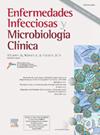Addressing catheter lock therapy: Does heparin reduce the bioactivity of dalbavancin when together in solution during freezing?
IF 2.5
4区 医学
Q3 INFECTIOUS DISEASES
Enfermedades infecciosas y microbiologia clinica
Pub Date : 2024-10-01
DOI:10.1016/j.eimc.2024.02.005
引用次数: 0
Abstract
Introduction
The possible use of dalbavancin as a catheter lock solution was previously demonstrated by our study group. However, it was needed to assess whether heparin could affect dalbavancin bioactivity during freezing storage.
Methods
We tested the bioactivity of a dalbavancin + heparin (DH) vs. dalbavancin (D) against Staphylococcal biofilms comparing DH median value of cfu counts and metabolic activity with that obtained for D before and during storage under freezing up to 6 months.
Results
Despite there was a slight decrease in the median percentage reduction of metabolic activity at month 3 in Staphylococcus epidermidis between DH and D (97.6 vs. 100, p = 0.037), considering the clinical criteria, no significant reduction in any of the variables tested was observed at the end of the experiment between D and DH solutions.
Conclusion
The addition of heparin to a dalbavancin lock solution did not affect its bioactivity against staphylococcal biofilms irrespective of its preservation time under freezing.
解决导管锁定疗法:肝素与达巴万星一起在溶液中冷冻时是否会降低达巴万星的生物活性?
我们的研究小组曾证明达巴万星可用作导管锁定溶液。然而,我们需要评估肝素在冷冻储存期间是否会影响达巴万星的生物活性。我们测试了达巴万星+肝素(DH)与达巴万星(DH)对葡萄球菌生物膜的生物活性,比较了 DH 与达巴万星在冷冻储存前和冷冻储存 6 个月期间获得的 cfu 计数和代谢活性中值。尽管在第 3 个月时,DH 和 DH 溶液的代谢活性降低百分比中值略有下降(97.6 vs. 100,=0.037),但考虑到临床标准,在实验结束时,没有观察到 DH 和 DH 溶液的任何测试变量有显著降低。在达巴万星锁定溶液中添加肝素不会影响其对葡萄球菌生物膜的生物活性,无论其在冷冻条件下的保存时间长短。
本文章由计算机程序翻译,如有差异,请以英文原文为准。
求助全文
约1分钟内获得全文
求助全文
来源期刊
CiteScore
2.10
自引率
8.00%
发文量
194
审稿时长
29 days
期刊介绍:
Hoy está universalmente reconocida la renovada y creciente importancia de la patología infecciosa: aparición de nuevos agentes patógenos, de cepas resistentes, de procesos con expresión clínica hasta ahora desconocida, de cuadros de una gran complejidad. Paralelamente, la Microbiología y la Infectología Clínicas han experimentado un gran desarrollo como respuesta al reto planteado por la actual patología infecciosa. Enfermedades Infecciosas y Microbiología Clínica es la Publicación Oficial de la Sociedad Española SEIMC. Cumple con la garantía científica de esta Sociedad, la doble función de difundir trabajos de investigación, tanto clínicos como microbiológicos, referidos a la patología infecciosa, y contribuye a la formación continuada de los interesados en aquella patología mediante artículos orientados a ese fin y elaborados por autores de la mayor calificación invitados por la revista.

 求助内容:
求助内容: 应助结果提醒方式:
应助结果提醒方式:


